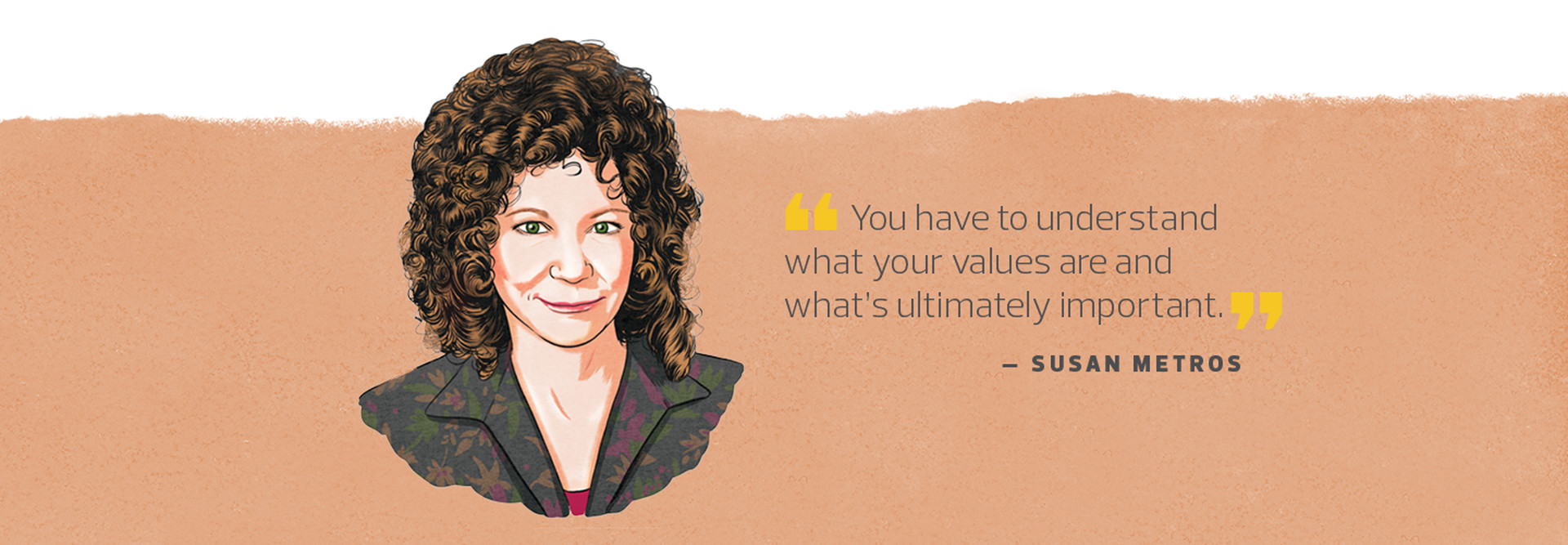Leading Edge: Former USC Deputy CIO Susan Metros Shapes Today's University Leaders
I never set out to be a leader. I was a professor and was given the opportunity to lead. I’ve had some good role models. I worked for Ohio State CIO Ilee Rhimes, and when he went to the University of Southern California to become CIO and vice provost, he recruited me and I worked with him for another seven years. He was an amazing leader. He’d never tell me I did something wrong. He’d ask, “How would you do that differently?” He was a good listener, was selfless and gave others the credit.
I’ve also had some bad leaders. You learn a lot from them. They serve as role models on how not to lead.
I used to have these debates with Ilee about whether leaders are born or made. I don’t think we ever came up with an answer. I believe you have to have the itch to lead and a propensity toward leadership. To be a successful leader, it’s a calling.
One of my strengths is that I’ve always been able to put myself in other people’s shoes and see their perspective. A lot of times, leaders try to force their ideas on others without asking, how do those affected feel about this? What are they afraid of? Why aren’t they getting on board? Is there some political agenda I’m missing? I want to identify issues early, acknowledge them and address them. That makes a big difference.
To implement new initiatives, you have to work incrementally. You can’t shove an idea down someone’s throat and mandate it. Sometimes you have to work through change in small steps. For example, at USC, I was able to convince the provost to provide ongoing funding to reimagine the university’s centrally managed classrooms, auditoria and computer labs.
SIGN UP: Get more news from the EdTech newsletter in your inbox every two weeks!
Learned Spaced Need to Be Adapted to Fit Today's Students
I believe learning spaces should be interactive, open and flexible. I like it when students come in and move furniture around numerous times during a class. I’ve taught three-hour classes where students sometimes sit at tables and at other times work individually or in groups on computers. We want to create environments that support different kinds of learning experiences.
Often in higher education, the facilities group is in charge of designing learning spaces. They often settle on the lowest common denominator: uncomfortable chairs, linoleum floors, poor sight lines. They don’t think about noise. There is a lot of politics around learning spaces. Registrars want to fit as many students as possible in a classroom because more bodies mean more tuition. Facilities wants to do it on the cheap because they have a lot of classrooms to maintain and want to standardize support.
In designing learning spaces, you have to sit down with all of the stakeholders and practice design thinking. You have to throw the net far and wide, consider everyone’s perspective and find ways to compromise. You have to respect how instructors are used to teaching and give them the tools and support to teach in new and engaging ways.

Technology is woven through all aspects of higher education. Sometimes university leaders think of technology as a commodity. They don’t realize it takes people to make machines run. I’d never accept a leadership role in IT that doesn’t report to the executive leadership, because technology is woven through everything. Almost every decision has a technological component. Universities need to understand the value of technology and how it underpins everything.
University Leaders Establish the Institution's Values
I don’t believe there is such a thing as a leadership style. Those are the things that self-help books profess, proclaiming you should be this style or that style. I believe you lead from what is deep within you. I was young when I became a leader, and I thought it was all about me. I realized quickly that was selfish.
It can’t be about you. It has to be about those who are doing the work, the people you are leading. Only you can create a purposeful leadership ideology. To do that, you have to understand what your values are and what’s ultimately important.
I’ve thought about the experiences I’ve had that have contributed to my leadership abilities, and they are diverse. When I was in my 50s, I learned to row crew. You row facing backward. The coxswain tells you what to do, and you and the other rowers must work together. It’s about trust, working in sync and not standing out. You stand out rowing, and the boat tips over.
Leadership ideology can also be gleaned from negative experiences. I got sick when I was young and almost died. When I left the hospital, I realized I needed to be surrounded by people who are true friends: givers and not takers. The leadership principle I learned was who you befriend makes a big difference.
I think values come first in any organization. You build this ideology based on your personal and professional experiences, and then you can translate those experiences into leadership principles. Think about your own experiences, from raising children to playing on sports teams, how you’ve organized things or developed a strategy in your personal life — that is how you build your leadership ideology.
What Comes Next for Metros
I am consulting with universities, foundations and businesses on their educational technology needs and coaching teams and individuals. As a coach and mentor, I help others cope with difficult work situations. I help people pivot careers and transition to leadership roles. I continue to learn, whether it’s reading books or taking online courses. There’s a quote from David Bowie that I often use on the last slide of my talks: “I don’t know where I’m going from here, but I promise it won’t be boring.” That’s my mantra.









